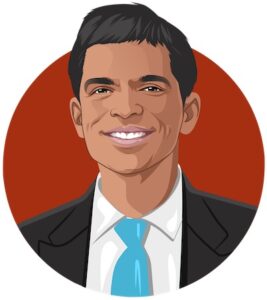10 1/2 Lessons from Experience
Author: Paul Marshall
Published: 2020
Buy the book here: Amazon
Why should I read it?
The book provides a short (116 pages) and easily accessible overview of basic principles for any investor. At the same time, there are many great references to other investors and books where you can take your learning further.
In addition to his own personal experience, Marshall has access to the assessments of thousands of analysts, economists, specialists around the world who have provided input on buying opportunities via Marshall Wace’s system called the Trade Optimized Portfolio System (TOPS).
For decades, Marshall Wace has been analyzing the input and results of the many participants in TOPS to support their own investment process. It has given Marshall a unique insight and was first described in the New York Times almost 10 years ago.
Paul Marshall
Paul Marshall is co-founder and chairman of Marshall Wace Asset Management, Europe’s largest hedge fund with assets of more than DKK 250 billion.
The company specializes in long-short investing and is known for combining fundamental investing with systematic and quantitative strategies.
Marshall was knighted in 2016 for his support and efforts in the field of education (and as a side note, his son is a member of the band Mumford & Sons).
The great disconnect
The book starts with a classic quote from American baseball legend Yogi Berra:
“In theory there is no difference between theory and practice. In practice there is.”
Anyone who has invested in the stock market will know that this is a very true statement. A strategy that seems completely obvious on paper can turn out to be the opposite in practice. The reason for the difference between theory and practice is multifaceted and unfolds in a number of Marshall’s experiences. You’ll find my favorites below.

Lesson #1: The market is inefficient
A basic premise of being an active investor and picking specific companies is that the market does not always price these companies correctly. If that were the case, everyone should just buy index funds. Based on the TOPS database, Marshall has unique insights to support the premise that it is possible to consistently ‘beat the market’. According to Marshall, there are a number of reasons why the market often prices a company too high or too low:
- Professionals get faster access to relevant information than private investors.
- Prices can diverge far from fair value due to supply and demand alone (also known as the scarcity principle: think water in the Sahara vs. in Ramlösa, Sweden).
- Today’s price development influences tomorrow’s. Also known as momentum and is fundamentally based on investors’ own psychological inclinations/biases (more on this below).
- The price development itself influences a company’s fundamentals and creates a so-called feedback loop. An obvious example that comes to mind is Tesla’s development over the past few years. Based on the exponential price increase, the company has the opportunity to finance new factories and reduce debt by issuing new shares (ref. Soros / theory of reflexivity)
The lesson here is that it will sometimes be possible to take advantage of market inefficiencies in setting the correct price. One specific opportunity that Marshall himself mentions is markets with a high proportion of private investors. In 2020, the US has around 15% private (“retail”) investors, whereas China has 85% (!). This means that a company is more likely to be mispriced compared to the market. fundamental value in China than the US. Maybe it’s worth looking more towards Asia.
“Market inefficiencies are visible every day to practitioners. But the anomalies do not automatically close. The challenge is having the conviction and the staying power and the process to exploit them.”
Lesson #2: Humans are irrational
For better or worse, we humans are social beings and rarely completely rational and objective. Every investor needs to know their own biases. Similarly, there is great value in knowing the human inclinations of others – and in this context, the market. Marshall builds on the work of psychologist Daniel Kahnemann and the field of behavioral finance.
In its simplifying assumption of overall averaged-out rational behavior, rational expectations theory conveniently steps over the fact that individual market participants on their own can often be extremely irrational. This makes for pretty weak science.
According to Marshall, the most significant human inclinations are:
- Stupidity: There is no ‘stupidity principle’, but there should be. People can have access to all the necessary information, but still make the wrong decision. It’s hard to quantify and doesn’t factor into economic models, but we all make decisions that we later find less intelligent.
- (Over) Optimism: We believe that we are less likely to experience a negative event than others. We’re persuaded by positive headlines and opportunities and will run with the pack for ‘the latest and greatest’. This tendency is also closely linked to our often romanticized belief in our own abilities and talent (called hubris by the ancient Greeks).
- Gambler’s fallacy: If something happens more often than it statistically should (think heads or tails), then it will happen less often in the future. It may feel like it, but rationally, the probability will be the same no matter how many times in a row you’ve flipped heads. As we all know, trees don’t grow into the sky and companies’ earnings and prices will often return to their average. But if the odds are favorable, an investor should not be swayed by the trend. In other words: You don’t necessarily have to sell your winners.
- Anchoring : When we let an experience or the first bit of information influence our judgment. Kahnemann has shown that simply seeing a high number influences our judgment on a completely disconnected question. Once we have seen the price of a given stock, we tend to use it as a starting point.
Lesson #3: Seek change
The biggest opportunities always come in situations where change is happening:
The valuation of a company will not change unless something changes intrinsically about the company (financially, operationally or strategically) or something changes about its economic/financial context (interest rates, growth, volatility, inflation to create or destroy value. […] Catalysts can matter simply because they create a story. Humans like stories.
An alternative approach to change-based investing relies on the fact that market participants are fundamentally bad at factoring in long-term (10+ years) growth and earnings. Therefore, an alternative approach is to buy and hold quality companies for many years. This model was introduced by Philip Fisher, who Warren Buffett himself has referred to as one of his two teachers (the other being Ben Graham). I’m a big fan of this approach myself – it’s simple and effective.
Lesson #4: Technology is not everything
A computer can now beat a human in many disciplines – think chess and now the Chinese game ‘Go’. But in the investment world – where there are infinitely many moving parts (a so-called chaotic system) – these models will always have their limitations.
A computer can help uncover, model and visualize data that would previously take days or weeks. But the computer is still a tool and a computer plus a rational and intelligent investor will still beat a computer alone, according to Marshall.
I fundamentally agree with this, however, it takes a very high degree of self-awareness and control not to be influenced by our many human inclinations. For the few who are able to remain rational, there is a benefit to be gained. But for the majority, a simple approach of continuously buying two to three diversified index funds (calculated from known factors by a computer) will provide a better return.
Podcast: Hear Marshall himself give his key takeaways
In conjunction with the book launch, Marshall was interviewed by Ted Seides on the highly recommended and free Capital Allocaters podcast.
You can find the full interview here – Capital Allocaters.





